Growth as a process
One misconception in Growth hacking is the one big idea/hack mindset. So we get founders talking to growth experts asking what one big experiment I can run that will bring in 300x growth like Dropbox or a massive initial push like Airbnb
It’s easier to believe that Dropbox’s growth success came from one idea about a referral program — but they fail to mention the hundreds of interactions required to achieve such a level of customer satisfaction.
People like to brag about Airbnb’s improvement on high-quality images and its impact on the early growth of the business — however, the story lacks the hundreds of unsuccessful experiments that were necessary to get to the ones that performed well. — GrowthHacker.com
What we try to do at Founders Factory Africa is to help founders in the program, debunk the mindset of growth as a one-off big idea but as a systematic process.
So the question to ask is not what did Dropbox do that gave them the hockey stick growth, but what are the little things they did that brought about the hockey stick growth.
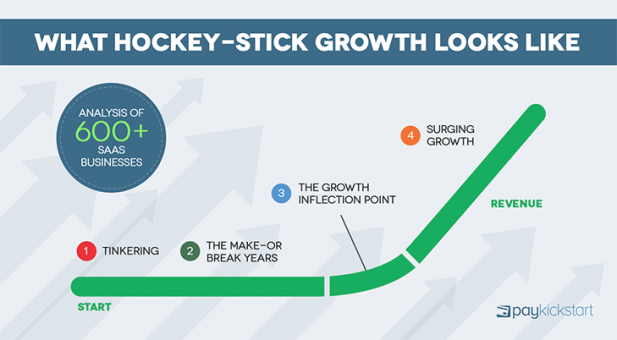
We need to start thinking about growth from a compounding perspective. Just like when you have a content strategy, 1–5% of your posts will get to the first page of google. Does that mean that the other 95% had no influence at all and could even not be written? No. Actually, without that 95%, it’s very likely that the 5% wouldn’t be on the top.

At the end of the day, while having a “Sean Ellis” in your team would definitely be beneficial, the secret doesn’t lie in one person, it lies in the constancy and consistency of your process. Set a system that makes it certain that tests will be run and you will eventually find yourself among the top performers. – Pedro Clivati.
Of course, there are a lot of different growth processes. Just as there are a lot of different conversion research models you could use or prioritization models you could use.
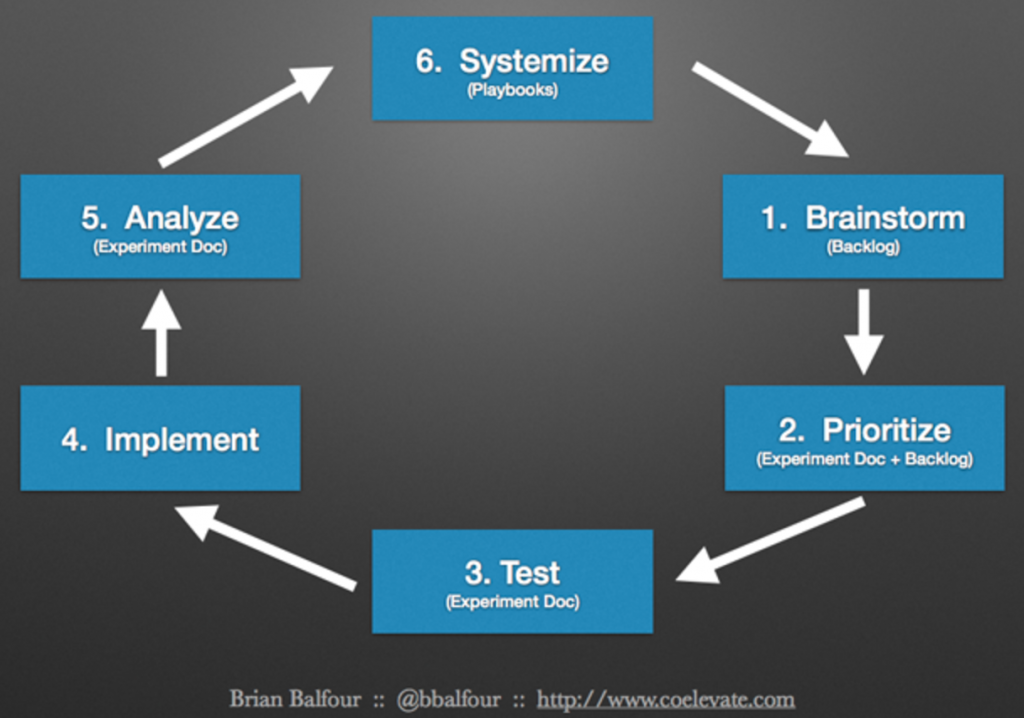
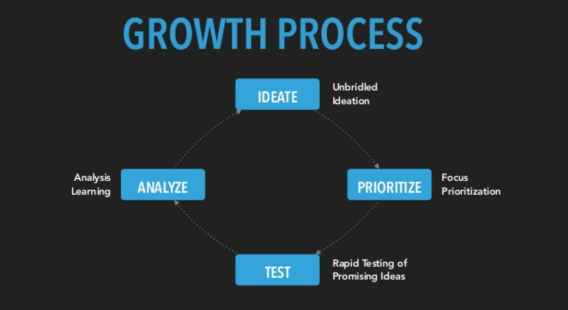
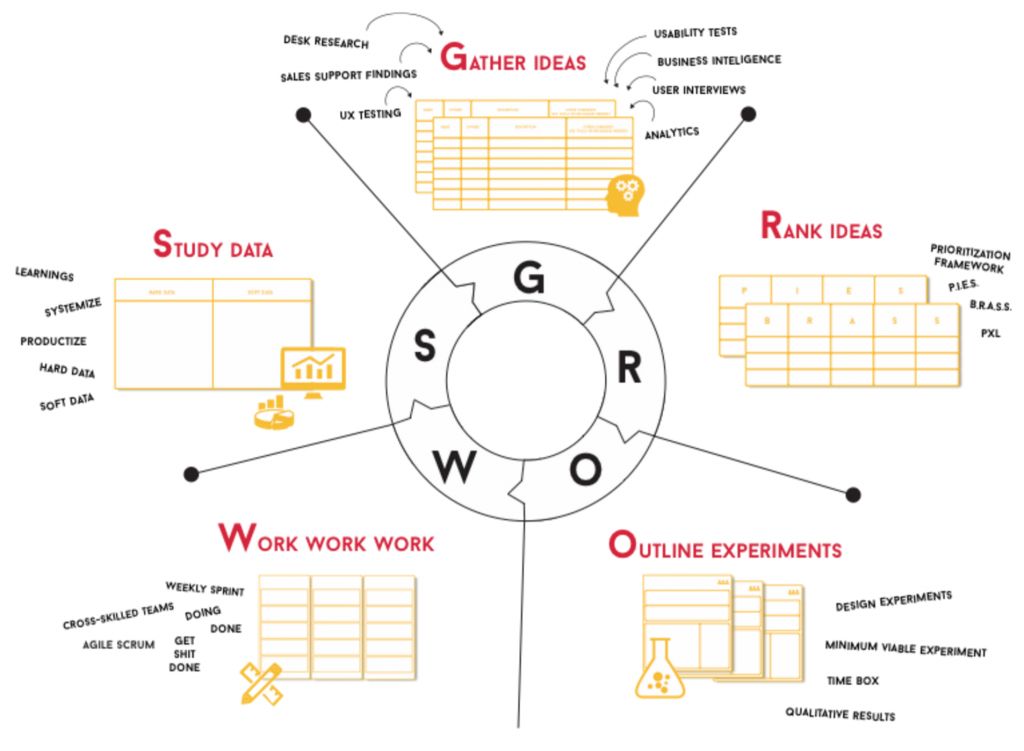
Different growth processes but all have key characteristics
- Generating ideas
- Prioritzing those ideas
- Implementation
- Iteration from learning
- Rinse and Repeat.
Aligning Growth goals and Business Goals
While the growth team can easily get carried away with running experiments, it’s important to know that running experiments and engaging in the growth process is not the end but a means to an end. So setting growth goals that align with the overall business goal is a crucial first step in the growth process.
If your company wants to drive up its user base, then your growth KPIs should be aligned to the goal.
Growth Process — Using G.R.O.W.S FRAMEWORK
In this session, I am going to show you how we use the G.R.O.W.S Framework in-house and how to use this framework to create an in-house growth engine for your startup. The G.R.O.W.S frameworks stand for;
- Gather ideas
- Rank ideas
- Outline Experiments
- Work, Work Work
- Study Data
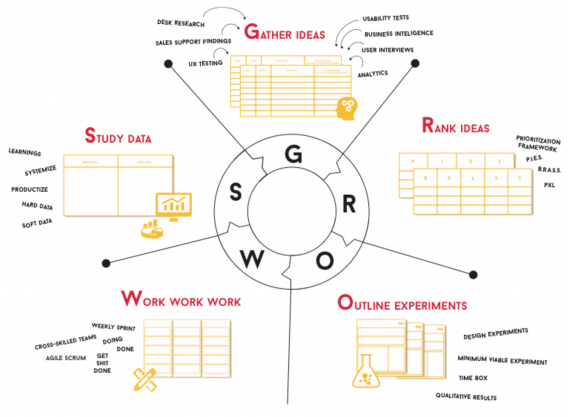
Gather Idea
The best way to have a good idea is to have lots of ideas — Linus Pauling
This is the idea generation stage, where we outline all ideas that will enable us to reach our goal. At this stage, it’s best to include all functions of the team not just limit it to the marketing and growth team. The product team can generate ideas from the product angle, the engineering team can also have development experiments that can also be used for growth.

We use the traction framework for this stage, we highlight potential experiments from the 19 different traction channels, which creates a backlog of experiment pipelines.
The point of the traction channel is to make sure you have at least 1 experiment for the 19 channels. It helps the team to think outside their comfort zone of channel expertise, identify low-hanging fruits and provide a backlog of experiments.
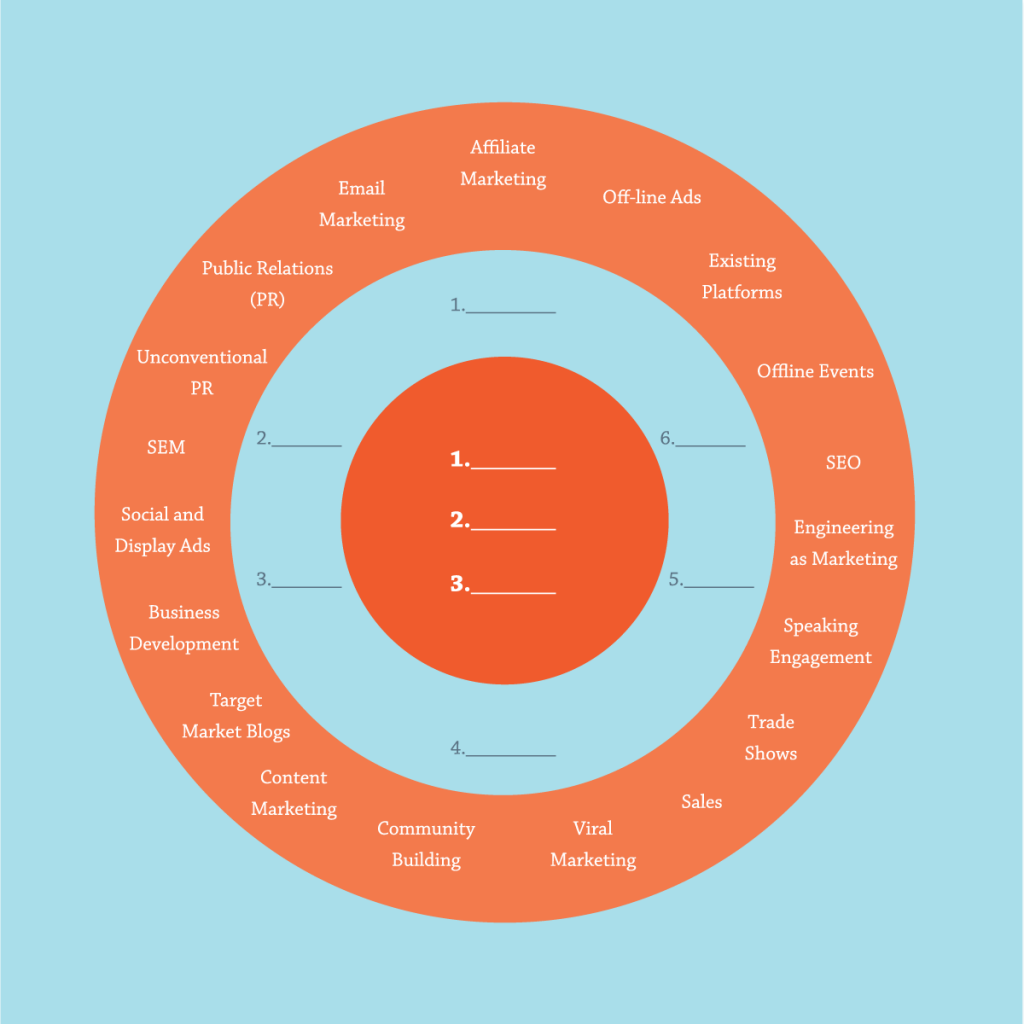
The ResearchXL framework
For a more advanced stage startup/company, In the Series A-C stage, you can also consider using the ResearchXL framework by ConversionXL. It focuses on doing full research on the website, to identify conversion and optimization opportunities. So using this framework can help you pinpoint conversion opportunities for your platform.
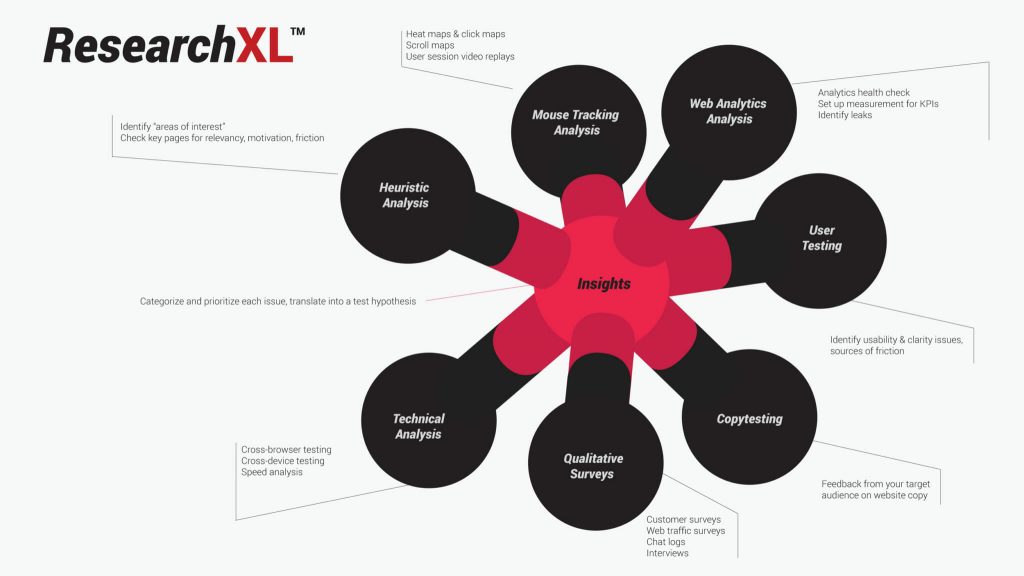
It looks like this:
Step 1. Technical analysis
- Cross-browser testing
- Cross-device testing
- Conversion rate per device/browser
- Speed analysis
Step 2. Heuristic analysis
- Identify “areas of interest”
- Check key pages for relevancy, motivation, friction issues
Step 3. Web analytics analysis
- Analytics health check: is everything being measured, is everything accurate
- Set up measurements for KPIs
- Identify leaks
Step 4. Mouse tracking analysis
- Heat maps & click maps
- Scroll maps
- User session video replays
Step 5. Qualitative research/surveys
- Customer surveys
- Web traffic surveys
- Chat logs
- Interviews
Step 6. User testing
- Identify usability & clarity issues, sources of friction
Step 7. Copy testing
Copy is the biggest driver of conversions in most cases.
Warning: This process can be quite complicated/advanced, so if you are starting out, have limited team/budget, I will advice to use the first framework to gather ideas.
Stage 2 — Rank those ideas

Still using the traction framework, after highlighting the experiments, you can then select 6 channels and experiments to focus on. Of course, as a startup you probably will have limited resources to run all experiments for the different 19 channels, so the framework suggests highlighting 6 channels that have the highest potential to make an impact and can be implemented by your team to start testing from.
It will be unwise to focus on an experiment that has run billboard ads when your marketing budget currently does not have the strength for that, so it will be a nice experiment to have in your backlog till the resources are available and focus on experiments that can be achieved with your resources and can move the needle.
Prioritization Framework
There are different prioritization frameworks but you just need one to work with.
- PIE Framework
- ICE Framework
PIE framework
- Potential — How much improvement can be made on the pages?
- Importance — How valuable is the traffic to the pages? (amount of traffic, etc.)
- Ease — How complicated will the test be to implement on the page or template?
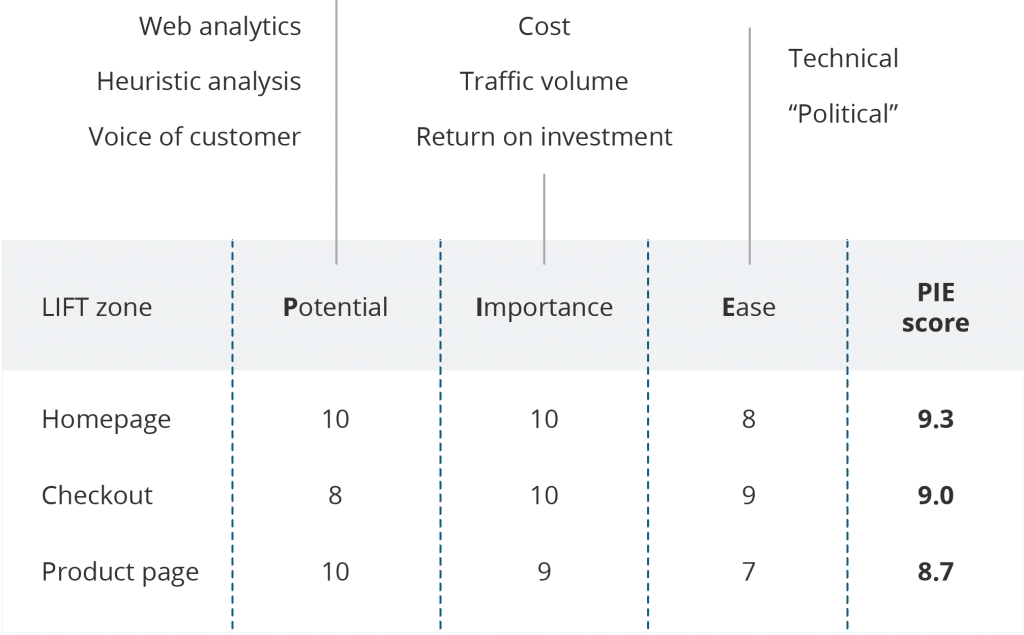
ICE Framework
The ICE Model helps prioritize ideas by multiplying three numerical values assigned to each experiment: Impact, Confidence, and Ease.
- Impact — How much we think the experiment can move the needle
- Confidence — How confident are you that this experiment will be positive or impactful
- Ease — How easy it is to implement
Each item being evaluated gets a ranking from one to ten(1–10) for each of the three values, those three numbers are multiplied, and given an ICE Score.
For Example; Impact — 7, Confidence — 8 Ease — 4; ICE score = 224
Prioritize based on the highest ICE score
Outline Experiment
Next is to outline your prioritized experiments and create a hypothesis mapping. We use the Strategyzer Test card —
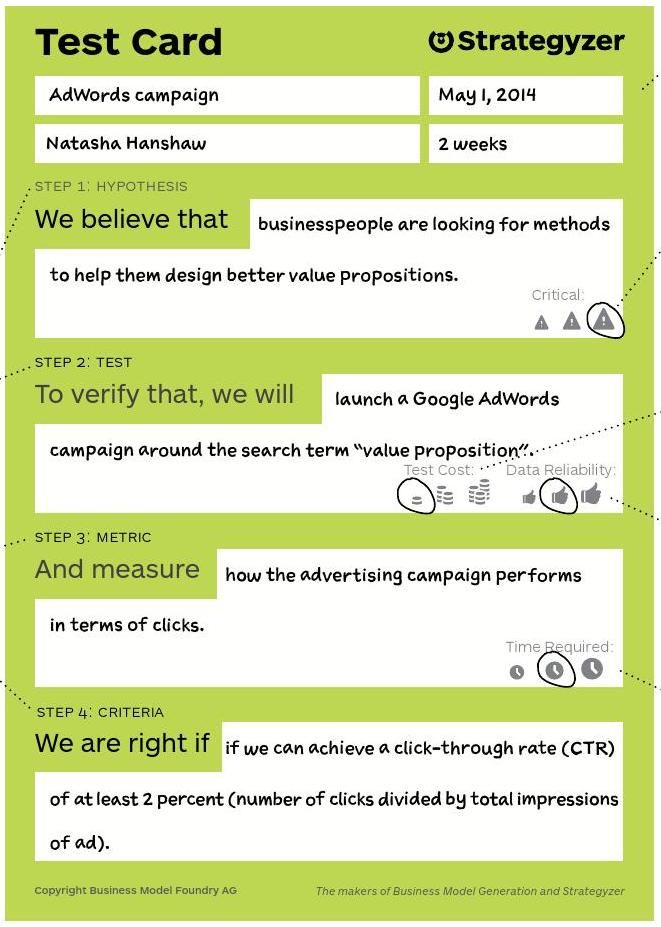
- Your experiment should have a hypothesis,
We believe that doing [A] for people [B] will make outcome [C] happen. We’ll know this when we see data [D] and feedback [E].
- Test method(A good experiment wrongly executed can turn bad).
- Metric to measure
- Criteria to show if your hypothesis is correct and the experiment was successful
I have also added in the template important information an experiment should have post-implementation
- Result/outcome of the experiment
- Insights got from the experiment
- Recommendations from the experiment
Remember we are trying to build a growth engine, and run experimetns that will move us to big wins, so learnings from each experiment is important and must be noted down.
Work Work Work
The phrase “It’s easier said than done”, is in its truest form when it comes to executing an experiment. It’s what differentiates a casual growth team and a growth engine.
Sometimes, experiments with an ease score of 9 can turn out to be more difficult than earlier anticipated, so instead of 1 day for implementation, it can end up taking 2–3 weeks needed for implementation. The key here is to know when to jump to another experiment.
Uber, Airbnb, Amazon, and Facebook are some of the fastest-growing companies in history, in part because they built high-velocity testing into their cultures from day one. Lindsay Pettingill, a data science manager on Airbnb’s growth team, reports that her team has increased their experiment cadence from 100 to 700 experiments per week over the past two years. — Reforge
As a startup, you don’t have to look at running 100 experiments weekly, but it’s important to make sure you run weekly experiments and keep a consistent number of experiments. You can decide to run 5 experiments weekly and keep to it.
If you’ve read to this point, I have a gift for you 🎁
I created a growth process template that you can use as you execute. If you want it, just write “Send me template” in the comment section and I will send it to your dm.
Use the marketing tracker in the template to keep track of the growth team’s activities/owner and make sure all activities are aligned to the prioritized experiments for the week
Study Data
Remember we are trying to build a growth engine, and run experiments that will move us to big wins, so learnings from each experiment is important and must be noted down.
Don’t start experimenting without Proper analytics to track results. It’s like shooting with your eyes closed and expecting to improve your shooting skills.
You need to make sure once the data starts coming in you can easily collect, analyze and iterate from the information gotten from the data
You will need/use the learnings gotten from the first experiment for other experiments.
Quick example, we ran an ad campaign for a particular project and realized that a particular message resonated with our target market and got the highest conversion, so we decide to use the learning for another experiment to increase signup. We saw an uptick in signup conversion, by just changing the copy. Learning we picked up from running another experiment.
EXTRA TIPS FOR BUILDING A GROWTH ENGINE
- Don’t be scared of failing: The 2020 State of Growth research found out that the most successful teams are also the ones failing the most. You can fail but make sure you fail forward.
- Growth team/Individual with a growth mindset: Most startups’ growth lead has a digital marketing mindset. Digital marketing and growth marketing is different by a whole lot. Get a growth lead with a growth mindset of experimentation, analytics, project management, research, and people management expertise, and bring in a growth associate with a more digital marketing focus.
- Collaboration and Support from other departments are key: Your growth team is a bridge connecting the marketing, engineering, product, and sales team together. They should not be treated in isolation.
- Executive Buy-in: Support from the Exec team can bring a lot of confidence to the team. Some growth experiments can include temporary tweaking of a feature, core messaging, business model, product, etc. Approval and buy-in from the Exec will be needed.
- Growth Weekly check-in/Standup: Having a weekly growth meeting to check in on growth activities currently running, what’s in the pipeline, learnings from growth experiments, and the next step is important.
- Right tracking tool(s) on the ground: Making sure you have the needed analytics platform to give you the needed data from your experiment is important before starting any experiment.
I sincerely hope you got value from this article, if you need the growth engine template, reply with “send me template”
Please Share, Share, and share again with other founders, early-stage marketers/marketing teams, growth teams, etc that will find this article valuable.




Hi Kate,
Please send me the template
Template sent to email.
Hope you got value from the article.